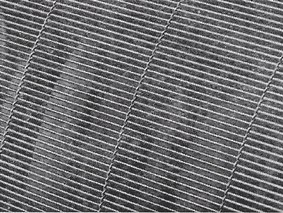LAID PAPER
Jeff Woolgar

Close-up view of chain Laid Danby showing twisted wires holding the lay wires in place.1

Close-up view of chain Laid Danby showing twisted wires holding the lay wires in place.1
Laid paper is so called because of the original Occidental method of producing handmade paper using a mould. This consisted of a hardwood frame supported by a number of thin transvers wooden bars on which wires were laid and fixed in position by hand. It was on these wires that the pulp created the laid watermark found in the resulting paper.
In machine made paper the laid lines are produced by a Dandy Roll - see picture above. Chapperton’s description for a laid dandy roll:2
For many years laid dandies were constructed in the same way as laid moulds, so far as holding the lay wires is concerned. The lay wires were held in position by two thin chain wires which were twisted once between each wire, in the same way as had been done with laid moulds for hundreds of years.
The chain wires were normally thinner than the laid lines and therefore sometimes difficult to see on the resulting paper, particularly in good quality cream laid paper. I have noted that in philately the direction of the laid lines has in the past, often been described as ‘vertical grain’ or ‘horizontal grain’. The problem here is that in the printing world, the word ‘grain’ is used to indicate the ‘machine direction' of the paper. Moreover, handmade paper has no machine direction (grain). In the case of machine made laid paper the machine direction may not necessarily coincide with the direction of the laid lines and is more likely to be in the direction of the chain lines. The terminology adopted by Stanley Gibbons and other Auction Houses, ‘vertical laid paper’ or ‘horizontal laid paper’ would be the best way to describe these papers. Where the paper appears at an angle in envelopes, ‘diagonal laid lines’ would be the best term to use.
Ledger paper will be found with about 16 to 18 laid wires to an inch,3 writing papers with 20, while tissue can have as many as 30 to 40. Within this grouping the number of laid lines can vary; blue and azure papers normally have fewer laid lines than cream or white papers.
Overall, the chain lines are between three-quarters of an inch to, one and a half inches apart. On the British made envelopes, used by the South African Republic Post Office during the 1870s, the chain lines are pitched at about one inch or more apart.
These papers can also have a watermark. The ‘bits’ of brass that make the design or lettering are attached to the laid mould (handmade) or laid dandy roll (machine made).
The range and choice of envelopes has always been vast, and could be custom-made to suit all requirements. As the fibres in laid paper are generally longer, than in wove paper, the resulting paper is stronger and normally opacity superior, it is not surprising that laid paper was commonly used for envelopes.4
References and Notes
1 Clapperton, R.H., (1952), p.343.
2 Clapperton, R.H., (1952), pp.339, 342.
3 I have deliberately used inches as this was the method of measurement used in British made paper during the period covered.
4 For more about the papers used for the South African Postal Stationery envelopes - see Woolgar, pp.57-59.
Bibliography
Chapperton, R.H., (1952), Modern Paper-Making, Basil Blackwell, Oxford.
Woolgar, J., (2006), Laid paper – with particular reference to the Davis stationery envelopes, The Transvaal Philatelist, v.41, No.3 (159), August 2006.
- - Return to Paper from Chafford and Roughway Paper Mills - -
- - Home page - -
Copyright © J. Woolgar 2005 and 2023
- - o - -